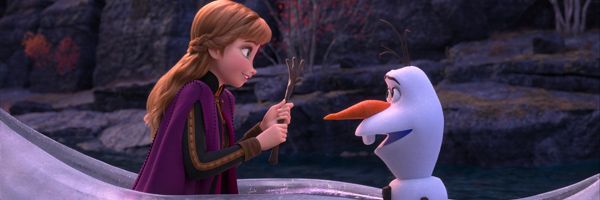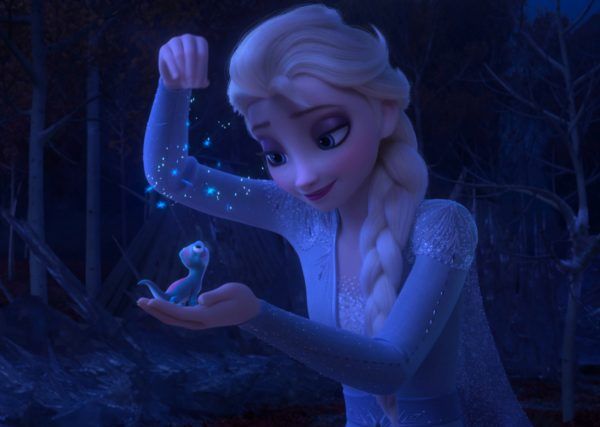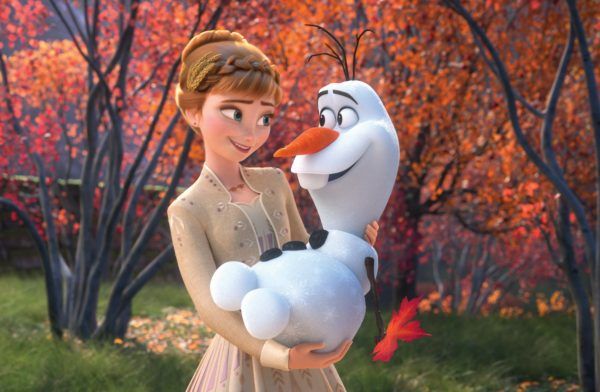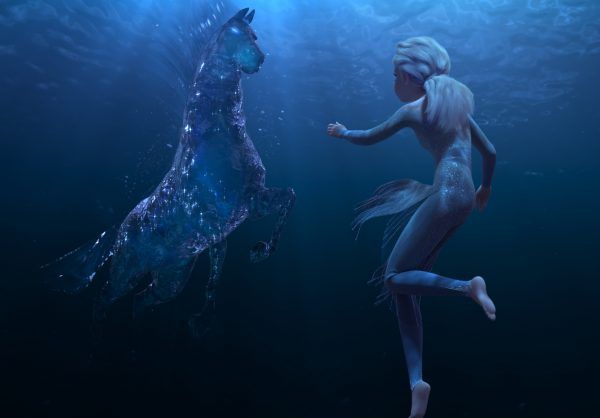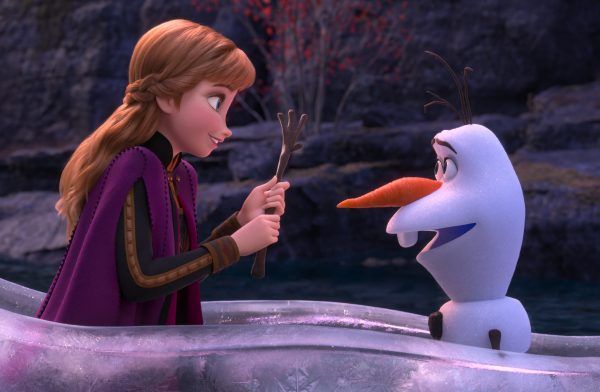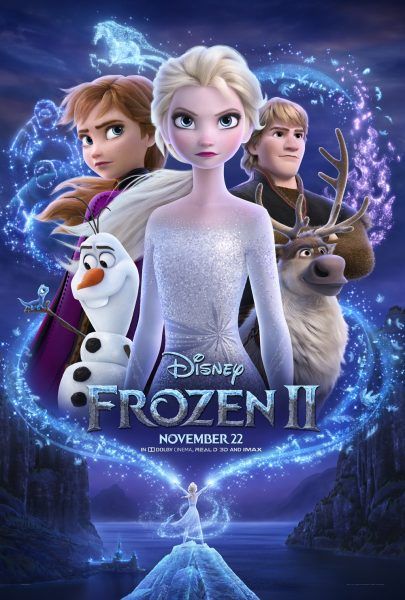Even though the filmmakers were still hard at work finishing the highly anticipated Frozen II in time for its November 22nd release date, they invited members of the media out to Walt Disney Animation Studios on September 6th to preview various parts of the film, as well as some of the new original songs. Directed by Jennifer Lee (who’s also the Chief Creative Officer at WDAS) and Chris Buck (Tarzan) and produced by Peter Del Vecho (who’s also Senior Vice President of Production, overseeing the production for all of the feature films at WDAS), the sequel to the highest grossing animated film of all time in worldwide box office will see Elsa (voiced by Idina Menzel), Anna (voiced by Kristen Bell), Kristoff (voiced by Jonathan Groff), Olaf (voiced by Josh Gad) and Sven set out on a dangerous journey to discover the answers to why she was born with magical powers, and they’ll learn whether those powers are enough to ensure their survival.
At an early preview day held at Walt Disney Animation Studios, Collider got the opportunity to sit down and chat with Jennifer Lee, Chris Buck and Peter Del Vecho about the development of the story for the sequel, journaling as the characters to help the filmmakers figure out what would come next for them, that second film evolved and changed just as much as the first one did, which characters got added the latest, looking at the first and second films as one complete story, whether they’ve considered a third Frozen film, coming up with the right song in the right place, and whether they’re developing more sequels now, as a studio.
And if you missed our list of 20 things you need to know about Frozen 2 click here.
Collider: Jennifer, Kristen Bell told me that she was very impressed with the work you’ve done on this because you spent months journaling as the characters. How did that help you find the story and decide what you wanted to explore with these characters?
JENNIFER LEE: It did a couple of things. We had spent some time off from them. We had given it to the world, at that point, and I wanted to ground myself back with the characters we’d built from here. Without having any pressure of time, at that moment, I wanted to see what came out and how it flowed. There are these things that come back, that you’ve forgotten. We learned, very much for Elsa, that she didn’t know what it was like to be accepted. She’d never experienced that, so therefore she didn’t even know herself, as this person. And wow, that’s a place to start. I didn’t know that because I had been writing a character who was living in fear and always struggling with being different, and not accepted. So, that was exciting to re-engage and discover, even as she was overwhelmed and confused herself. And then, for Anna, having a character who was fearless and had nothing to lose for our first film, and now she’s at a place where she has everything she’s ever wanted, but in that place, has the fear of losing that, and how that will change her because now she has everything to lose, that came through. That really helped us know that there is a new place to go with these characters, but it’s absolutely true to where they’d be, right now.
Chris, and while all of this journaling was happening, did you sit at home and come up with the inner life of Sven?
LEE: Well, funny you should say that.
CHRIS BUCK: I do that, every day. I have four dogs, and they’re all Sven. No.
LEE: I would bring [the journals] in, every day. It wasn’t one of those things where I got to go off, for four months and sit on the beach, and he had to figure out something else to do. I’d bring it in and we’d talk about it, and that would inform where things were going. So, he couldn’t escape it, either.
BUCK: And we were already starting to talk about visuals, and stuff like that, working with the other departments, at the same time she was still writing.
How much did the story develop and evolve, over the years of doing this? What were the biggest changes that happened?
LEE: It’s so funny, it will be easy to talk about what those big changes were, after the film comes out. It’s hard. Obviously, characters come and go, because you try them and three characters become one when you only need the one, and songs come and go.
BUCK: A song can fit one version, and then suddenly that version changes and it just doesn’t work anymore.
LEE: It was the same process with the first.
PETER DEL VECHO: It evolved just as much as the first one did. There is no shortcut, and there is no easy path.
BUCK: The one thing that we were lucky enough with the first one, and are lucky enough with this one, was that we had an ending for the first movie where we knew that’s where we wanted to go. Earning it was no small feat, but at least we knew what that was. And the same was true for this one. We knew that we liked where the ending was. We were happy and satisfied with where everyone is. That was the journey, again, to find that.
What was the latest character that got added?
LEE: Well, here’s something that was interesting: Long ago, there was lots of talk about, how much magic do you add? And is Elsa the only magical being in the world? There were lots of debates about that. And I think the thing that really spoke to me was this notion of Elsa getting to understand that her powers come from nature, and what if her powers were too much, or not enough, ‘cause you face that in life. Originally, there were very few magical creatures. The elements were a tug of war. And then, the breakthrough in the story, to really look at Elsa, as she learns about her magic and confronts her magic, and these antagonistic forces that keep driving her forward were magical, that felt really great. It just took a lot of wrestling to get there. So, there was a version of this where there was maybe only one of those characters. There was maybe just the wind spirit.
BUCK: Yeah, they were a little more in the background. And then, we brought they up to the forefront.
LEE: They grew. So, that wrestling with magic was a big thing. And then, when we just let them be more true to our story, they grew. Some of them have come to the forefront, even more, in the last month, because they spoke loud and clear.
BUCK: Elsa doesn’t do spells. It’s not generic magic. It’s so specific. It’s ice and snow. Her power is elemental. It’s of nature. So, that’s why we always went back to that connection, and why these elements were so interesting to use with that, to support her journey.
You’ve previously talked about how the first film felt like the beginning of the story. Does this feel like the middle of a story, and that we could get a third film, or does it feel like the conclusion of the story that you wanted to tell?
BUCK: It’s hard to say.
LEE: We’re just finishing this one, so it feels like, “No, no, we’re done!”
BUCK: We did look at 1 and 2 as one complete thought, and when you see it, you’ll understand that.
LEE: When we did the first film, it felt complete to us. We weren’t thinking of a sequel, until a year later, when we started asking questions. I feel the same exact way now, so ask me in a year.
Peter, you’ve previously talked about how there are so few sequels to the Walt Disney Animation films. Does it feel like you are developing more now? Will any of the films we’ve seen before get more sequels?
DEL VECHO: It goes back to the filmmakers. If there is a story that the filmmakers feel they want to tell, it comes from that. We don’t pre-plan sequels. We’re not told to do it, by the studio. So, it has to start with the filmmakers.
LEE: Our focus, as a studio, is still on originals. Ralph and Frozen lined up, partly because they were ready when they were ready, but the filmmakers themselves had driven it. We do have a number of originals slated for our features.
Could there ever be an animated Tron movie?
LEE: There was an animated Tron in Wreck-It Ralph. Well, never say never.
BUCK: And my wife worked on Tron, so I’ll tell her.
With a sequel like Frozen, you not only have the pressure of coming up with the right story, but you also have the added pressure of new songs. Is it equally as nerve-wracking to figure out what the right song is, in the right place?
LEE: It was like that for the original, too. This is the first animated musical sequel that we’ve ever tried, so how to look at that was very daunting, at first. Then, it was also very freeing ‘cause no one had done it, so there was no precedent.
BUCK: If you approach it from the idea of, “Oh, my god, we have to follow up Frozen 1,” it can be nerve-wracking, but that’s not how we made the first movie. So, it was about working through character, working through plot, really understanding the story we were trying to tell, and then letting the songs evolve from that. We brought the songwriters on that whole journey with us, which was the secret to the first movie, and that also worked on the second movie.
LEE: We did it the exact same way.
BUCK: How Bobby [Lopez] and Kristen [Anderson-Lopez] wrapped their heads around it was that they looked at it as Frozen 1 was Act 1 of a Broadway musical, and Frozen 2 was Act 2, so they could go a little deeper and a little richer with all of it, as you do in any musical. That was exciting to them, and exciting us.
Frozen II opens in theaters on November 22nd.

